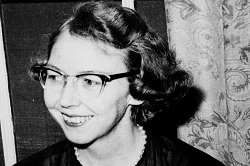 I’m not completely sure what this post has to do with happiness or intentionality, except that unexpected connections can be a source of pleasure. So this shot was taken on our hike last week, the one that was supposed to have us end up at Blue Lake but which ended considerably before that because there was so much snow still on the trail.
I’m not completely sure what this post has to do with happiness or intentionality, except that unexpected connections can be a source of pleasure. So this shot was taken on our hike last week, the one that was supposed to have us end up at Blue Lake but which ended considerably before that because there was so much snow still on the trail.
From Eudora Welty it was a short leap to Flannery O’Connor, another Southern writer whose tragically short lifespan (39 years) overlapped Welty’s more robust 80. Both women included characters in their fiction that have been called “grotesque,” and O’Connor especially has been categorized as Southern Gothic. She has a very funny response to her critics: “Anything that comes out of the South is going to be called grotesque by the northern reader, unless it is grotesque, in which case it is going to be called realistic.” Both women have written novels and short stories and have been honored in various ways. Welty won the Pulitzer prize for literature in 1973. O’Connor’s novel Wise Blood has appeared on the list of 100 greatest novels of all time. (One of those lists, anyway.) I would have to say that I started Wise Blood once and simply could not get very far in it; it was so dark, so . . . grotesque. Her short stories are a little more palatable but still not the stuff of beach reading: two that I remember well concern, on the one hand, a traveling Bible salesman who steals a girl’s wooden leg, and the other, a woman who gets gored by a bull. For some reason I decided that the latter was a good candidate for a reader’s theater performance in a grad school class I took; some of us really got on a Flannery O’Connor kick for awhile. I find her fascinating: she was a devout Roman Catholic who believed fervently in the presence of God and grace in the world, but she refused to write any kind of obviously apologetic literature. Her stories can be very violent, as in yet another story I remember, “A Good Man Is Hard to Find,” in which an entire family is murdered by an escaped convict and his gang.
Two fascinating, talented women who had their heyday during the mid-1900’s, when American women were supposedly confined to wearing pearls as they did the vacuuming. Whether I’d care to read anything more by them at this point in my life, I was happy to be reminded of them and their work. (And this post was a nice excuse to re-read the two Welty stories referenced here.) O’Connor somewhat resembles my husband’s mother, who died in 1989 and whom I never met, but whose letters are small works of art. (Hey, maybe someone should publish them!)
I’ve thoroughly enjoyed writing this rather self-indulgent post. At this point I’ve pretty well exhausted the material from our trip. On to the future!


Interesting view, Debi. I read O’Conner’s “Death of the Archbishop” for our book club selection of the month earlier this year. I read it twice, hoping I would actually end up not wishing I had wasted my time, but, no such luck. I missed the discussion for this book also (wish I hadn’t).